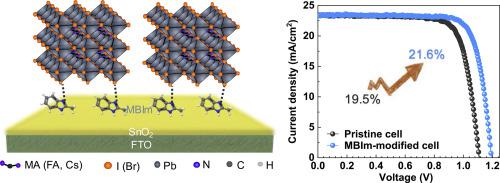Nano Energy ( IF 17.6 ) Pub Date : 2020-07-07 , DOI: 10.1016/j.nanoen.2020.105127 Savas Sonmezoglu , Seckin Akin

|
Despite the tremendous progress in the efficiency of perovsite solar cells (PSCs), nonradiative recombination losses, mainly associated with the interfacial defects, still remain as a challenge that hinders their commercialization. In this study, we report a facile interface engineering strategy for highly-efficient planar PSCs by employing in a series concentration of 2-methylbenzimidazole (MBIm) between SnO2 electron transporting layer (ETL) and photoactive perovskite layer. The preliminary results demonstrate that MBIm molecules reduce the band‐offset and enlarge the built-in potential (Vbi) between perovskite and SnO2, resulting in a lower photovoltage loss. Besides, MBIm provides an efficient passivation by donating the lone pair electrons to the uncoordinated Pb2+ ions in perovskite structure through the formation of Lewis adducts, thereby minimizing nonradiative recombination in the ensuing devices. As a result, a remarkable increase in the efficiency from 19.5% (pristine cell) to 21.6% (3 mM-MBIm modified cell) was achieved with a dramatic increase in VOC (~90 mV). Meanwhile, an admissible improvement in long-term stability was obtained by retaining ~85 and 90% of initial performance under high humidity and continuous light soaking conditions, respectively. The prolonged stability is ascribed to the formation of compact and high-quality perovskite layer deposited on the modified surfaces. We believe that this study offers an efficient strategy by minimizing the nonradiative recombination losses through ETL/perovskite interface for high-efficiency and stable perovskite cells.
中文翻译:

通过使用2-甲基苯并咪唑作为中间层抑制界面依赖的非辐射复合,实现高效稳定的钙钛矿太阳能电池
尽管过孔太阳能电池(PSC)的效率取得了巨大进步,但主要与界面缺陷相关的非辐射复合损失仍然是阻碍其商业化的挑战。在这项研究中,我们报告了通过在SnO 2电子传输层(ETL)和光敏钙钛矿层之间使用一系列浓度的2-甲基苯并咪唑(MBIm)来实现高效平面PSC的简便接口工程策略。初步结果表明,MBIm分子减少了带隙偏移并扩大了钙钛矿与SnO 2之间的内在电势(V bi),从而降低了光电压损耗。此外,MBIm通过形成路易斯加合物,将孤对电子提供给钙钛矿结构中未配位的Pb 2+离子,从而提供了有效的钝化作用,从而使随后的器件中的非辐射复合最小化。结果,随着V OC的急剧增加,效率从19.5%(原始细胞)显着提高到21.6%(3 mM-MBIm修饰细胞)。(〜90 mV)。同时,在高湿度和连续光浸泡条件下,分别保持约85%和90%的初始性能,从而获得了长期稳定性的可接受的改善。延长的稳定性归因于沉积在改性表面上的致密且高质量的钙钛矿层的形成。我们相信,这项研究通过将ETL /钙钛矿界面对高效和稳定钙钛矿细胞的非辐射重组损失降至最低,从而提供了一种有效的策略。



























 京公网安备 11010802027423号
京公网安备 11010802027423号